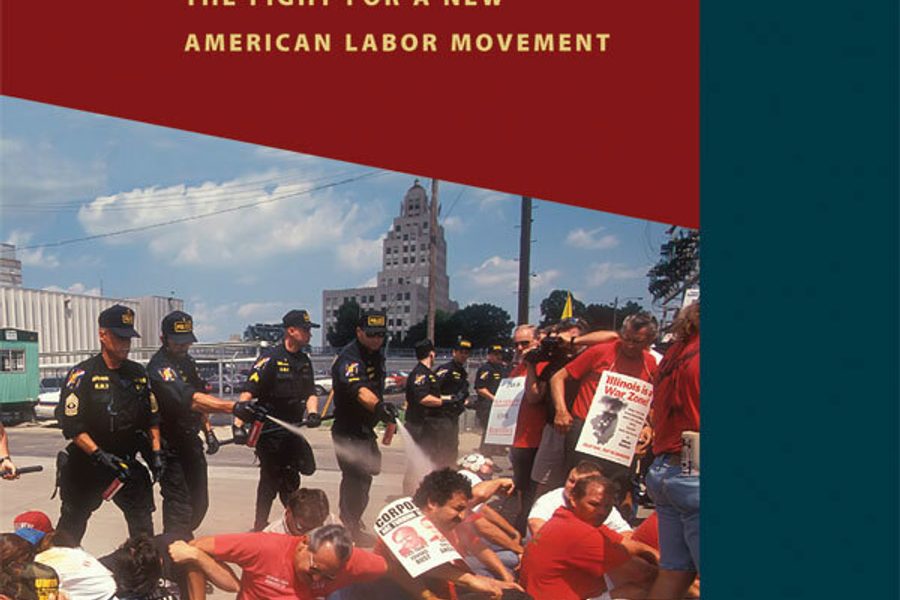Prairie Fire
A bitter labor conflict ultimately failed in Decatur, Ill., during the mid-’90s. But a new book argues that tactics developed there by locked-out workers strengthen today’s labor movement.
Stephen K. Ashby and C.J. Hawking

On December 22, 1995, a slim majority of workers locked-out out of the A.E. Staley Co. plant in Decatur, Ill. voted to accept a company proposal that spelled their own defeat. So ended what was perhaps the longest and most high-profile conflict between a corporation and organized labor to occur during the 1990s.
The workers, locked out of their jobs over a contract dispute since June 1993, had succumbed to financial pressures or fears of inflicting serious wounds on their corn syrup-producing factory and its owner, British-based Tate & Lyle. More than half of the members of Allied Industrial Workers Local 837 accepted modest severance pay offers.
In These Times Senior Editor David Moberg covered the two-and-a-half year conflict closely, reporting from central Illinois on both the Staley struggle and simultaneous strikes at Caterpillar plants throughout the region. “The Staley workers had started on a high note of remarkable rank-and-file activity and solidarity but ended in a painful morass of division and recriminations,” Moberg wrote in “All Quiet on the Midwestern Front,” just after workers decided to end the lockout.
The conflict began in 1991, when Staley management demanded new 12-hour shifts (which rotated between days and nights), drastic job cuts and an unrestricted company right to subcontract work, among other things. This convinced workers that Tate & Lyle was intent on busting their long-established union.
But rather than strike and be replaced by nonunion workers, in late 1992 the Staley local began an “inside campaign” (also known as a “work-to-rule campaign”). While demonstrating solidarity inside the plant, unionists did only what company rules required of them. Nine months later, on June 27, 1993, Staley retaliated by locking out workers.
Two former Staley workers’ solidarity organizers, Steven Ashby and C.J. Hawking, tell the story of the Decatur struggle in their new book Staley: The Fight for a New American Labor Movement (University of Illinois Press, April). The passage below narrates – with dramatic details drawn from interviews with former Staley workers – the final month leading up to the lockout. It focuses on how and why workers walked off the factory floor after one union member was fired for insisting on complying with the company’s own safety manual.
Whether or not Staley workers could have won better working conditions if they and their union allies had pursued different strategies is still a matter of debate. But what Moberg wrote more than a dozen years ago remains true today: “If the labor movement wants to be a new voice for American workers, then it is going to have to find a way to turn more of the efforts by determined workers like those at Staley into real victories.”
Jeremy Gantz, In These Times Web Editor/Associate Editor
The temperature rises
By May 1993, eight months into the work-to-rule campaign, Local 837 was preparing to take even bolder steps.
The workers had been escalating their in-plant actions week by week, but the debilitating impact of the rotating twelve-hour shifts had sapped some momentum. An in-plant campaign “is an uneven process,” said Jerry Tucker [head of the UAW New Directions movement, who advised Staley workers on the campaign]. “You’re moving along, you think you’re making progress, and all of a sudden it flattens out… So you try to figure out ways to give it a boost.”
In mid-May the members initiated a grievance blitz. Across the plant, unionists in every building gathered together and marched to the supervisor’s office to confront management over working conditions. The action lifted the workers’ morale, but it was clear to Tucker that something more was needed.
On May 19, a serious chlorine bleach spill occurred inside the plant. Dangerous conditions such as this were commonplace, and if one were to strictly follow Occupational Safety and Health Administration guidelines, the spill could require that virtually the entire plant be shut down. The union, however, didn’t jump on the opportunity. Instead, as during past safety incidents, [Local President] David Watts negotiated a safe cleanup with the plant manager.
At the next union meeting, Tucker discussed the chlorine spill to show how the workers could escalate the fight: the next time there was a safety incident, they could walk off the job in a “safety stand-down.” “A safety stand-down is when something becomes significantly unsafe in the minds of the workers,” explained Tucker. “Then a worker should take the necessary steps to stand down and take himself out of harm’s way… Then everyone on the shift would join the worker that was having the problem, and workers would converge on the union hall to discuss the safety crisis in the plant.”
Staley worker Dan Lane recalled that Tucker told the workers, “Twenty years from now, you are all going to be sitting back in a rocking chair; the grandkids will be on your knee. It is not a question whether this is history. It already is. But the question is: What are you going to tell your children? Whose side are you on?”
Worker walkout
On June 16, workers walked off the job. It began in the morning with a minor incident: union recording secretary Ron VanScyoc refused his foreman’s order to change a burned-out light bulb. In past years this would have been a simple task any worker would agree to do. But now, following company work rules, an electrician was required to do the task. Recalled VanScyoc,
The supervisor told me that I should write the safety work order for changing a light bulb. I explained to him that if I wrote the safety work order, then I would be violating the safety manual, which had been set up for everybody’s safety. I would be subjecting myself to possible discipline, including discharge. Different supervisors kept coming to me and saying you have to write the safety work order… Finally they said, “You’re going home.”
Gary Taylor jumped on the in-plant radio, declaring “Code Bronco P-3,” signifying that a worker was being fired. “About twelve or fifteen workers appeared instantly in the control room,” remembered VanScyoc. “Every one of them was on the supervisor’s back. [Management] called plant security.” A supervisor then fired Taylor for “improper use of company property” (the radio) and threatened to suspend eleven other workers who came to support VanScyoc. The workers called the union hall and consulted Tucker and bargaining committee chair Jim Shinall. Tucker said, “This is the right time for the safety stand-down.”
Word rapidly spread throughout the plant. Workers excitedly spread the news that the union had called a safety stand-down, and if they wanted to know what the safety problem was, they had to come to the union hall immediately. An overwhelming majority of the 270 workers on the day shift walked off the job.
Former union president Bill Strohl recalled that some of his co-workers struggled with their decision: “I was working with [treasurer] Mike Grandon when we heard the news, and he says to me, ‘Well, what are we going to do?’ I told him we are going to meet out at the union hall. It was a touchy thing because nothing like that had ever been done before. I went to change my clothes, and the boss said to a group of workers nearby, ‘If any of you leave, you’re all fired.’”
Strohl shrugged his shoulders at the boss’s threats and left the plant. When Dike Ferris heard that Taylor had been fired and that a safety stand-down had been called, he knew instantly that he was walking out. As Ferris was leaving, he was confronted by a couple of workers. “I’m not leaving here,” declared one. “You may cause me to get fired.” “We’re either in this thing together or we can take our separate paths,” answered Ferris, “but that’s where I’m headed.”
At 1 p.m. the workers met in a mass safety meeting at the union hall. The hall was abuzz with conversations. Ron VanScyoc and Gary Taylor went to the microphone and told the members what had happened. The excitement in the air was palpable, and many workers were in awe of what they had achieved. Staley worker Gary Lamb recalled the jubilation:
As you’re going out the gate, people were saying, “Is anybody going to follow me?” “Are you going?” “I’m going!” “Is anybody else behind us?” Finally they all went. It had to make the company really wonder how that many middle-aged souls, tied up in a job that long, could have that much courage to just individually walk out that gate.
The supervisors were dumbfounded. Management scrambled around, placing calls to the home office in London for advice. They called the union office and demanded to know whether the union was going to order everybody back to work. The leaders said they would formally respond after a 6 p.m. union meeting with the next shift. At a packed meeting that evening, the membership voted to stay out until the next day. In an act of further defiance, they would report at 7 a.m. – an hour later than they were due at work – since this had been their starting time before twelve-hour shifts were imposed.
‘Solidarity forever’
At six o’clock the next morning, over 1,000 workers and family members held a spirited one-hour rally outside the plant. Wearing their red union T-shirts and carrying banners and homemade signs, members shouted “Union!” and “Solidarity!” Spouses and children cheered the workers on as they headed back into work.
Staley management stopped the workers from entering the plant, however, declaring that each would be required to sign a statement agreeing to the terms in the contract the members had overwhelmingly rejected. The workers refused to sign and returned to the union hall, with the exception of two lone workers who entered the plant. Union leaders formally notified the company that the workforce was ready to return to work, but under no circumstances would they sign individual statements.
Advised by their lawyers that the agreements were blatantly illegal under the National Labor Relations Act – which prohibits employers from bargaining directly with individuals rather than with the union – the company relented. After 32 hours off the job, the unionists returned to the plant at 6 p.m. on June 17. The entire shift marched into the plant singing “Solidarity Forever” at the top of their lungs. “You would have thought we were all Johnny Cash,” recalled Dave Watts, “the way we were singing.”
A week later a ruling from the National Labor Relations Board forced the company to reinstate Gary Taylor and cancel the eleven suspensions.
Meanwhile, for weeks the Staley workers and UAW 751 had been planning a demonstration in which a 2.6-mile human chain would extend from the Staley plant to the Caterpillar plant [where a labor-management dispute was occurring]. The success of the walkout the week before gave new energy to the demonstration. On June 26, Staley and Cat workers and family members were joined by a 50-car caravan of Caterpillar workers from Peoria; over 100 AIW workers from the Milwaukee Harley-Davidson plant, who roared into town in a motorcycle caravan; Oil, Chemical, and Atomic Workers members from St. Paul, Minnesota; unionists from Chicago; and striking mine workers.
Four thousand people formed a human billboard of solidarity. A 20-foot banner declaring simply “Solidarity” was unfurled from a tall Staley building by a unionist working the weekend shift.
Allied Industrial Workers International president Nick Serraglio and regional director Danny Wirges spoke, encouraging the workers to continue their struggle. Dave Watts declared, “Today is the day that we send the union-busters…a message: You don’t belong in central Illinois. Go back to where you belong. This is our turf and we’re going to keep it that way.” Watts praised the solidarity of the spouses and families, declaring their courage “one-half of our battle.”
Within 24 hours, however, the lives of the Staley workers and their families would be forever changed.
To order or learn more about Staley: The Fight for a New American Labor Movement, visit the authors’ Web site.




